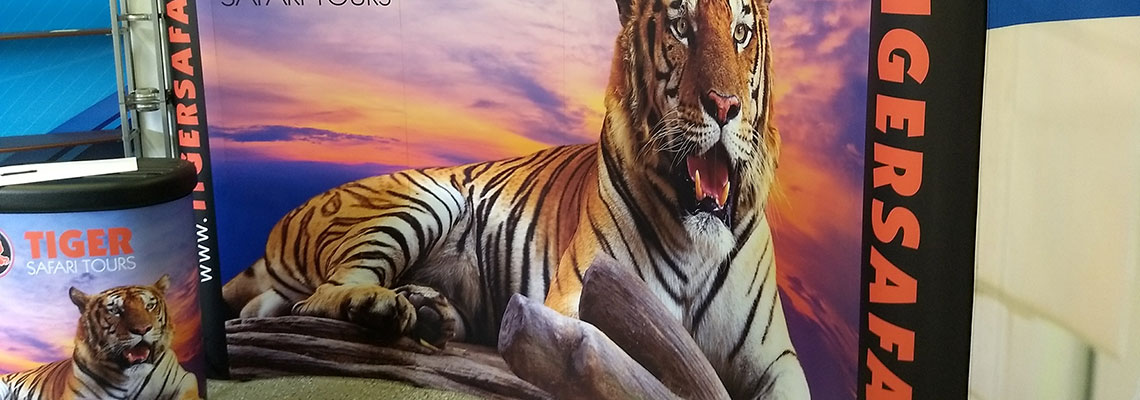
From hunting to weddings and everything in between Toronto offers a massive selection of popular trade shows at world-renowned centres such as the Metro Toronto Convention Centre and the Direct Energy Centre at Exhibition Place.
The days of solid, rigid and heavy exhibit booths might not be over, but an increased use
of structures using tension fabrics is making the lightweight and portable components far more common in the trade show industry.
Enhanced lighting and graphics applications combined with savings on shipping and drayage costs are making more exhibitors turn to tension fabrics for use in their exhibits.
Choosing a Trade Show Display
The variety of trade show display types and graphic materials can be a bit overwhelming to start, but with a few key questions you can quickly narrow down the best trade show materials for your company.
- What is the booth size?
- Will your booth size vary?
- What is your total budget for the show?
- How many individuals will be working the show?
- What are the marketing and sales objectives?
- How will the display be transported to the show?
- Will custom graphics need to be created?
These questions can help narrow down your scope, so you can ultimate choose the display and materials that work best for your situation.
The trade show display decision should consider your company’s trade show objectives, marketing budget, and your branding goals. For example, a small mom-and-pop shop would require a smaller, less flashy design that one for a nationally recognizable brand.
Tension Fabric Trends
One major contribution to the increased popularity of trade show displays is the evolution of lightweight frames combined with tension fabrics, making today’s displays extremely light and portable. Former popular, rigid construction is declining as trade show exhibitors find ways to have the best of both worlds; amazing colours and graphics combined with a durable yet easy-to-manage frame.
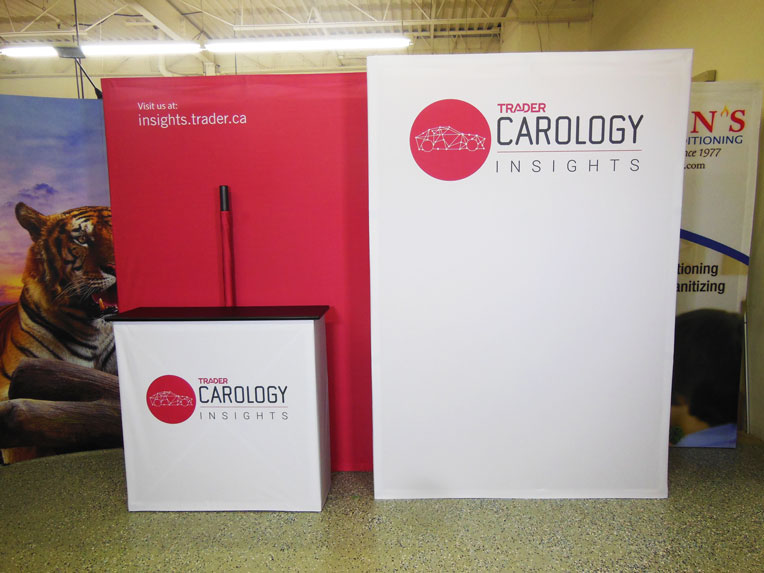
Tension fabric on a traditional pop up frame.
Tension fabric systems that utilize a traditional pop up frame make a great low-budget solution but are only available in a standard straight or slightly curved frame style.
Pillow case style tension systems that utilize lightweight, aluminum tubing create a great opportunity to get outside the traditional trade show box that is, to experiment with curved or parabolic designs. This type of framing system utilizes 1 1/2” or 2” diameter aluminum tubing that can be constructed with horizontal curves, vertical curves or even custom parabolic shapes.
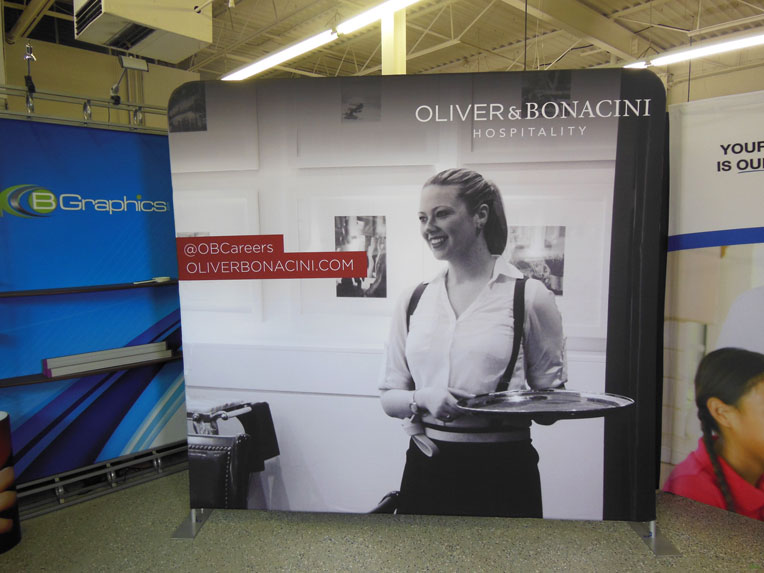
Pillowcase style aluminum tube framing
Tension fabric structures can also be combined with LED lighting solutions to provide an additional appeal. Spotlighting and backlighting are very popular choices with companies that want their cutting-edge brand reflected in their promotion materials.
Whether in trade booth components or stand-alone promotions, tension fabric designs can attract attention with bright, bold colours on high-quality fabrics that are easy to install for quick setup and teardown at trade shows and events.
Features and Benefits of Tension Fabric Displays
- Easy snap button assembly
- Lightweight
- Create unique serpentine or parabolic shapes
- Large fabric graphics can be seamless
- Save money on shipping costs
Pop up Displays

Pop Up Display Frame
Traditional pop up displays are still a popular choice for spaces at sales events and conferences. There is a wide range of pop ups and most are available with podium wraps to convert your carrying case into a podium or small table. Further, panel displays can be complemented with shelving, peninsula counters, backlit headers, literature racks, and other accessories which can convert an ordinary panel display into unique marketing tool.
Some of the key factors to look at in selecting a pop-up are the quality and durability of the printed graphics, ease of setup, and warranty. If you sometimes exhibit in smaller spaces, you could consider a convertible booth which can be easily converted to a smaller size.
Each display booth uses a frame that can "pop up" allowing the display to be easily assembled and torn down in minutes. They are made of different components, some graphite, steel, and/or extruded aluminum. Most suppliers would argue their frame is the strongest, the lightest, or simply the best. You could equate it to the myriad of different HD televisions now available on the market. Though, when broken down to its bare essence, no one is any better than the next. Further, most of these displays have one thing in common... a lifetime manufacturers warranty on the frame.
The same cannot be said of the graphic panels on a pop up display which vary greatly in their quality. This is where you can find a wide variation in price and quality for what is supposed to be “the same” pop up display. The type of printer (UV, ink-jet or eco-solvent) that’s used, the quality of print media and laminate (if it’s included) will affect the price and long-term performance of the panels.

A photo of an actual 18 mil trade show panel produced at KCB Graphics.
Panels printed with a UV printer on 20pt styrene that are not laminated will be considerable cheaper than a panel printed with an ink jet printer on 18 mil PVC with a quality pebbled laminate. Most people would assess these as the same pop up display panels but the latter panel will outperform in durability, print quality and long-term performance.
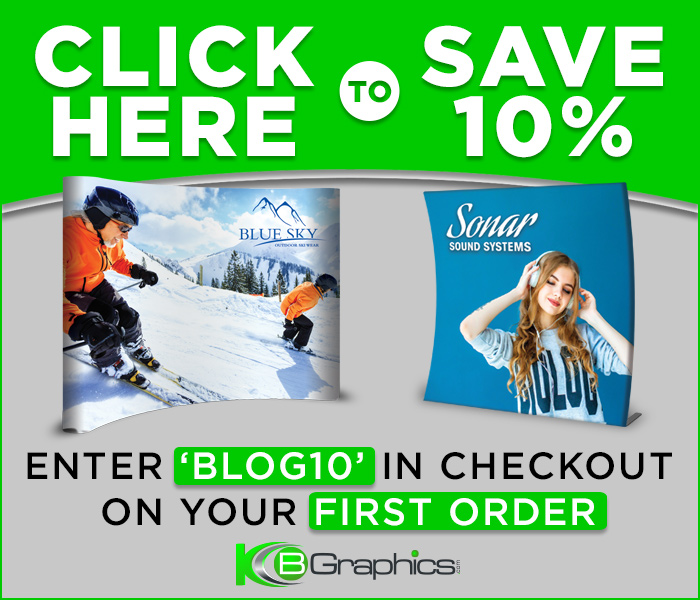
Today, marketers must achieve their goals with reduced budgets. Again, Pop Up Displays will assist you in stretching your budget because they are lighter weight and designed for easy setup and tear-down. Further, you will save on storage, transportation, and labor costs.
Features and Benefits of Pop up Displays
- The frame pops up in seconds and assembles in 5-10 minutes
- Lightweight
- Shipping case doubles as a podium that can be wrapped with graphics
- Save money on shipping costs
Modular Panel Exhibits
Panel systems give you an extreme amount of flexibility of design choices as displays can be custom created to your needs. Flexibility also abounds in colour selection as upper and lower panels can be different. Most come with panels utilizing fully customized dye sub fabric graphics.
Modular Exhibits are high-end exhibits that provide a custom look but can still be setup in a few hours, shipped in standard rotomolded plastic cases, and thus have a lower total cost of ownership than custom booths.
Modular exhibits generally use higher end materials including tension fabric structures, extruded aluminum frames, high-end composites and laminates, and innovative bold designs. Modular exhibits will hold more weight and can also be used to hold large plasma screens and LCD panels.
Features and Benefits of Modular Displays
- Easily reconfigure for smaller or larger both sizes
- Simple add-ons for video presentations, lighting and tables
- Large seamless graphics spanning 10 feet to 30 feet
Truss Display Systems
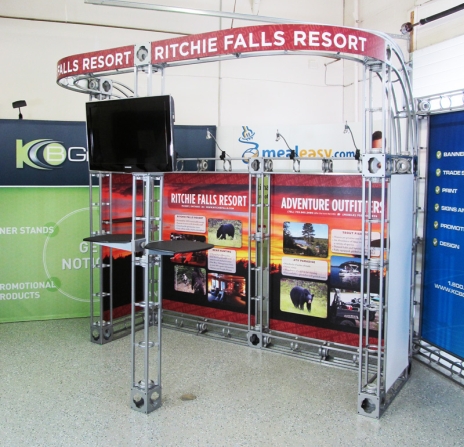
Truss Style Trade Show Display
Truss Systems provide a brash, modern, and unique look to a display. They are also excellent functional components that can be used to mount lighting, projectors, and Plasma or LCD panels. The fact that truss systems have a high weight-bearing capacity makes them great for displaying heavier weight products like computers, machine parts, free weights, etc. They also have a unique industrial look that works well with certain target markets. The beauty of truss systems is the ability to be used in conjunction with other display structures like Pop Up and Panel Systems.
Features and Benefits of Truss Displays
- Very modular
- Easily reconfigured for 10' 20' of 30' booths
- No tools required for assembly
- Structural trusses allow for the easy addition of large monitors or other addons
- Heavy duty shipping cases are included
What is Dye Sublimation Fabric Printing?
Dye-sub, or dye-sublimation printing is commonly used to print on synthetic fabrics, including trade show banners. Using traditional dye sublimation printing each image is printed first on coated, heat-resistant paper and transferred as a reverse image to the fabric by using a heat press. The high temperature and pressure converts the dye into a gas that permeates the fabric and then solidifies - this creates a permanent transfer so the fabric can be washed without reducing quality. Fabric graphics are then finished with either Velcro or zippers depending on the framing system that’s been chosen.
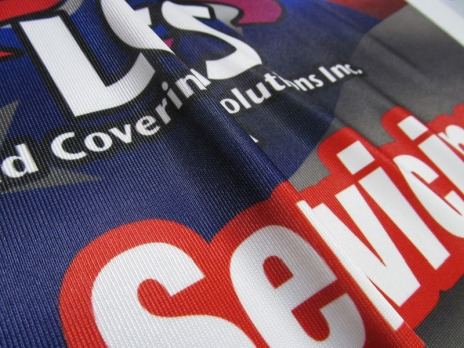
Dye Sublimation Fabric Printing from KCB Graphics
Advantages of Dye-Sublimation Fabric Printing
- Ink is infused into the fibers providing a permanent image transfer
- Excellent saturation provides colours that are very bright and vibrant
- No peeling or fading
- The dye won’t build up in the fabric
- Continuous tones can provide a near photograph effect
- Light weight fabric can be folded and packed in small boxes
The disadvantages of dye-sub graphics are few; polyester fabrics are not opaque and can wrinkle when packed away.
What is Inkjet Printing on Semi-Rigid Panels?
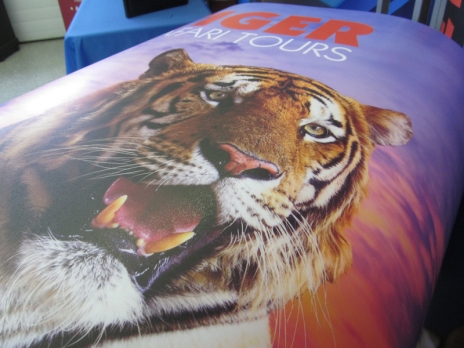
An 18mil trade show panel with a pebbled laminate.
Wide format, inkjet printing utilizes equipment capable of printing widths from 54 inches up to 120 inches in at resolutions up to 1440 DPI. Trade show graphics are typically printed on a 14 to 20 mil PVC panels and allowed to dry for 24 hours at which time they’re laminated with a 3 to 5 mil pebbled laminate to provide long-term protection from fading or scratches.
Advantages of Inkjet Printing
- High resolution images are printed at photographic quality
- 18 mil PVC panels are completely opaque, allowing through no backlight
- Lamination protects your graphics from scratching or fading
The disadvantages of ink jet printing on semi-rigid panels are few; aligning graphics across multiple panels can be challenging and panels should be packaged carefully to avoid shipping damage
With each of the above-aforementioned display types and printing methods, designing attention-grabbing graphics for your booth is essential to setting yourself apart from your competitors. Below, you will find some important strategies to consider:
- The 10 foot rule. Make sure all logos and text can be clearly read from a distance of 10 feet (i.e. Rule of thumb for text is 2" per 10' of distance viewed)
- Limit bullet points to 10 words or less... Less is more.
- Infuse a bounty of visual images to elicit emotion and make your exhibit unforgettable
- Make your logo simple to view even from a long distance. You want to make sure that your target audience can find you at a glance. High visibility is a priority.
- Consider using mural graphic panels to increase the value and emotional impact of your display. Remember, "Perception is Reality!"
Remember, purchasing a trade show display allows you complete freedom of expression. Be cognizant that the exhibit design should revolve around your specific trade show needs. The Trade Show Display, Exhibit or Booth should project your company's individuality, character, and panache.
Over time purchasing a new trade show display may be your most economical long-term solution to your trade show needs. Once you've answered the questions presented earlier and understand the dynamic differences between the many display options, you will be more informed and better suited to create your new display space.
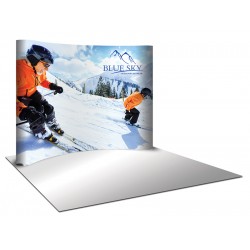
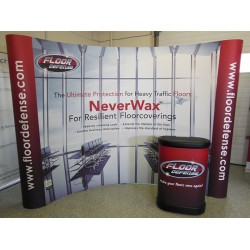
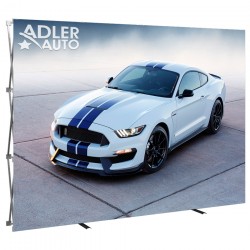
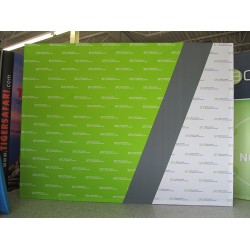
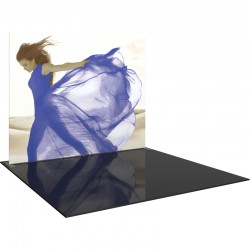
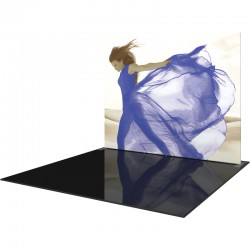
Leave a Comment